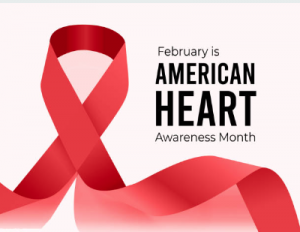February is considered by many the month of love with Valentine’s Day being its focus, so what better month to also celebrate the other “matters of the heart”? According to the American Heart Association (AHA), one in four deaths in the USA is caused by heart disease. Resent research also shows that many of us lack education about cardiovascular conditions, warning signs, and preventative measures. The purpose of American Heart Month is to urgently address awareness deficiency by initiating thoughts of simple ways to maintain a healthy heart. Because heart disease in America is so far-reaching, many Americans raise funds for heart-related organizations through charitable activities, events, and campaigns. You can help by donating to organizations, including the American Heart Association, WomenHeart: The National Coalition for Women with Heart Disease, and the World Institute on Disability.
in four deaths in the USA is caused by heart disease. Resent research also shows that many of us lack education about cardiovascular conditions, warning signs, and preventative measures. The purpose of American Heart Month is to urgently address awareness deficiency by initiating thoughts of simple ways to maintain a healthy heart. Because heart disease in America is so far-reaching, many Americans raise funds for heart-related organizations through charitable activities, events, and campaigns. You can help by donating to organizations, including the American Heart Association, WomenHeart: The National Coalition for Women with Heart Disease, and the World Institute on Disability.
Understanding the Function of the Heart
The human heart weighs between 8 and 12 ounces, it’s approximately the size of a fist, and sits slightly middle-left in the chest. The size of the heart does not compare to how grand its job is. It works feverishly to pump blood in and out of its four chambers. The two upper small chambers are called the atria. The two larger lower chambers are the ventricles. The right side of the heart accepts blood that is low in oxygen because most of it has been exhausted by the brain and body. It pumps this to your lungs, where it picks the oxygenated blood. The blood then returns to the left side of the heart, ready to be pumped back out to the brain and the rest of your body. This process occurs roughly 60-80 times per minute through electrical cells called “pacemakers.”
Implementing Good Heart Health
Heart disease settles in when the arteries leading to the heart become clogged. The best way to protect the heart is to be active, think about cholesterol and blood pressure levels, eat a healthy and well-balanced diet, and minimize daily stress levels. According to the American Heart Association, one must also be aware of the warning signs of heart disease: shortness of breath, general tiredness, nausea or lack of appetite, confusion, coughing/wheezing, and a fast heart rate. Visit the US Department of Health and Human Services’ Office of Disease Prevention and Health Promotion to learn more about heart disease prevention, confirming if you are at risk, ways to take action, and additional facts about blood pressure and cholesterol levels for prevention.